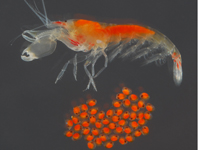Abstract
The very uncommon alpheid shrimp Bermudacaris britayevi Anker, Poddoubtchenko & Marin, 2006, previously known only from the incomplete holotype from Nha Trang Bay, Vietnam, is recorded from Guam, Mariana Islands, extending its previously known distribution range into the oceanic islands of the western Pacific. The single specimen from Guam, an ovigerous female, was collected adjacent to a near-shore coral reef, on fine sand under a large piece of coral rubble, at a depth of about 10 m. This habitat is different from the collection data of the holotype, which was extracted from a burrow of unknown host on an intertidal sand-mud flat close to mangroves. Despite these ecological differences, the specimen from Guam corresponds to the holotype of B. britayevi in all diagnostic morphological characters and can be distinguished from the closely related B. australiensis Anker & Komai, 2004 and B. harti Anker & Iliffe, 2000. Since the holotype of B. britayevi was lacking one of the chelipeds, the complete specimen from Guam enables to complement the original description of the species. The stouter (= major) cheliped of the Guam specimen is illustrated to show a marked difference in the armature of the cheliped fingers, between the left and right cheliped. The colour pattern of B. britayevi, which was superficially described in the original description, is herein illustrated by photographs of the living individual. The relatively low number and large size of eggs in the Guam specimen of B. britayevi suggests an abbreviated larval development in this species.
References
Anker, A. & Iliffe, T.M. (2000) Description of Bermudacaris harti, a new genus, and species (Crustacea: Decapoda: Alpheidae) from anchialine caves of Bermuda. Proceedings of the Biological Society of Washington, 113, 761–775.
Anker, A. & Komai, T. (2004) Descriptions of two new species of alpheid shrimps from Japan and Australia, with notes on taxonomy of Automate De Man, Coronalpheus Wicksten and Bermudacaris Anker and Iliffe (Crustacea: Decapoda: Caridea). Journal of Natural History, 38, 1895–1914.
https://doi.org/10.1080/0022293031000156312
Anker, A., Poddoubtchenko, D. & Marin, I. (2006) On the presence of the alpheid shrimp genus Bermudacaris Anker and Iliffe, 2000 (Crustacea: Decapoda: Caridea) in the Pacific Ocean, with description of a new species from Vietnam. Journal of Natural History, 40, 1675–1686.
https://doi.org/10.1080/00222930600937734
Gràcia, F., Jaume, D., Ramis, D., Fornós, J.J., Bover, P., Clamor, B., Gual, M.À. & Vadell, M. (2003) Les coves de Cala Anguila (Manacor, Mallorca). II. La Cova Genovesa o Cova d’en Bessó. Espeleogènesi, geomorfologia, hidrologia, sedimentologia, fauna, paleontologia, arqueologia i concervació. ENDINS, 25, 43–86.
Ledoyer, M. (1970) Étude systématique et remarques écologiques sur les Caridea recueillis principalement dans les biotopes de substrat meuble. Régions de Tuléar et de Nosy-Bé. Annales de l’Université de Madagascar (Sciences Naturelles et Mathématiques), 7, 121–157, pls. 1–25.
De Man, J.G. (1888) Bericht über die von Herrn Dr. J. Brock im indischen Archipel gesammelten Decapoden und Stomatopoden. Archiv für Naturgeschichte, 53, 215–600., pls. 7–22a.
https://doi.org/10.5962/bhl.part.4747


